
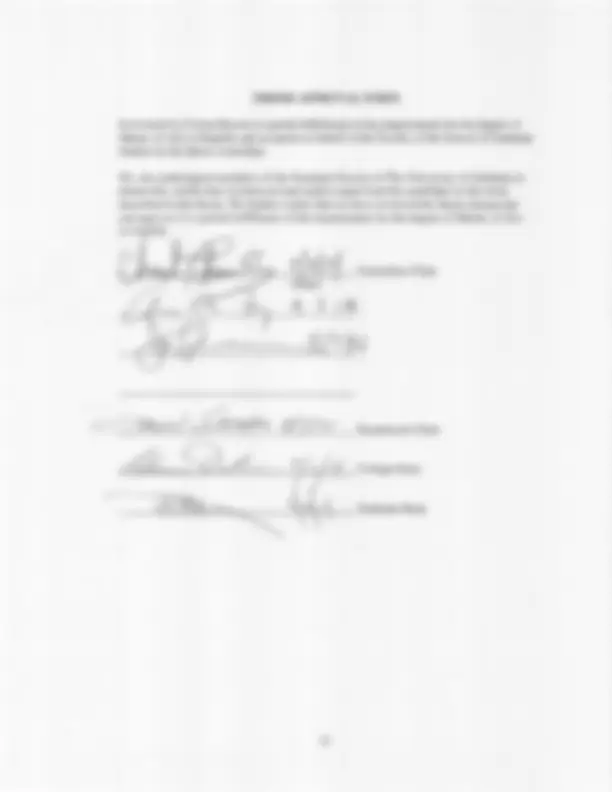
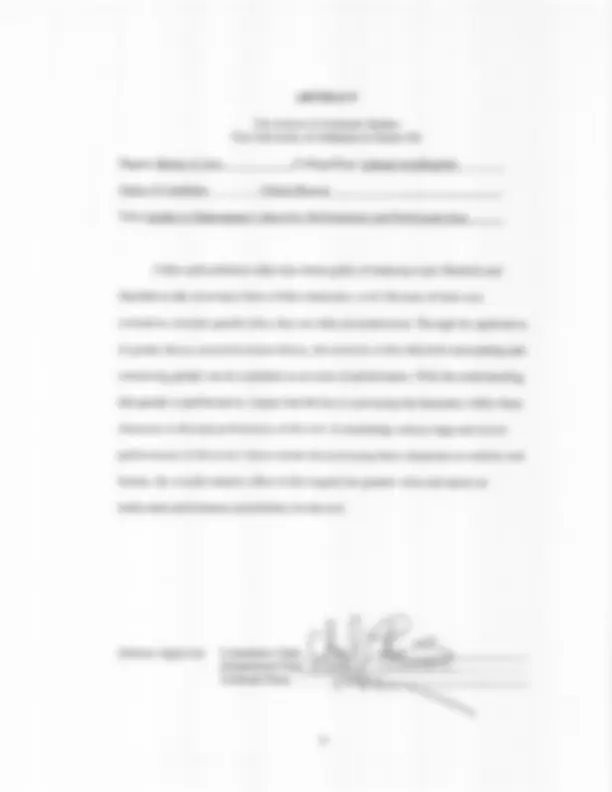
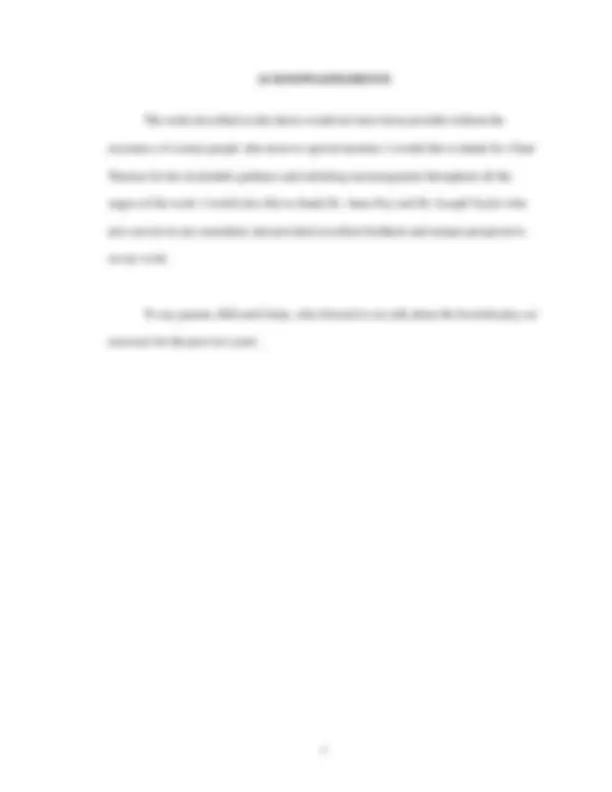
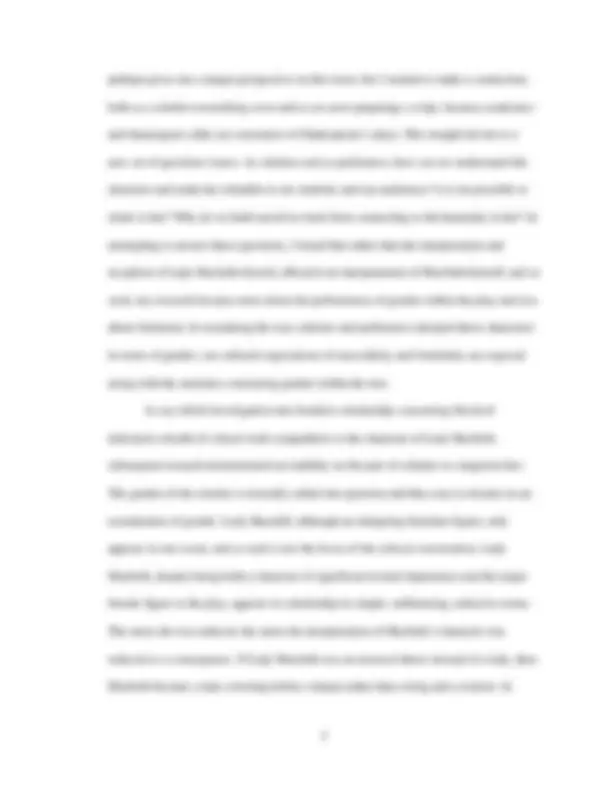
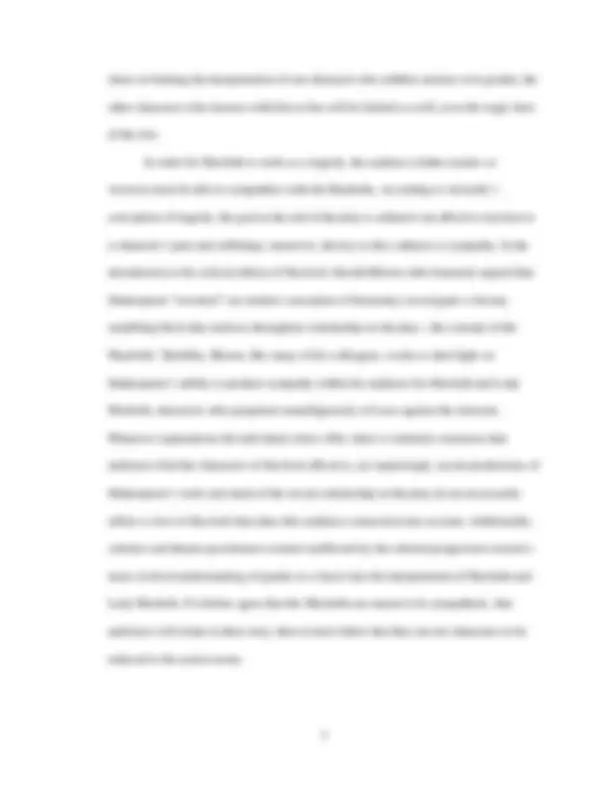
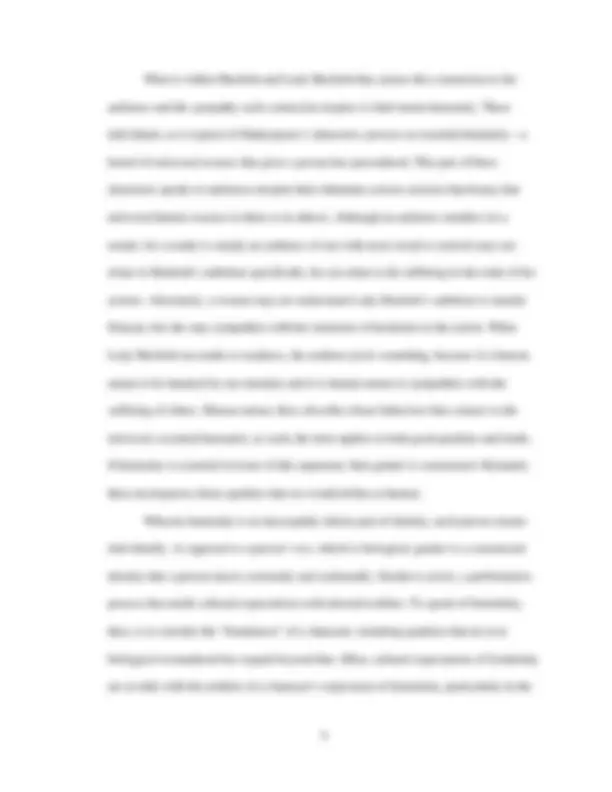
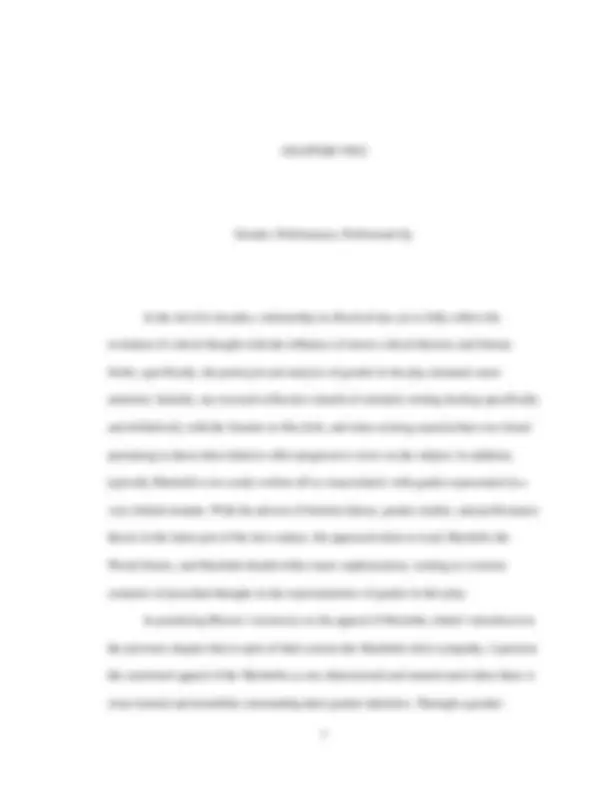
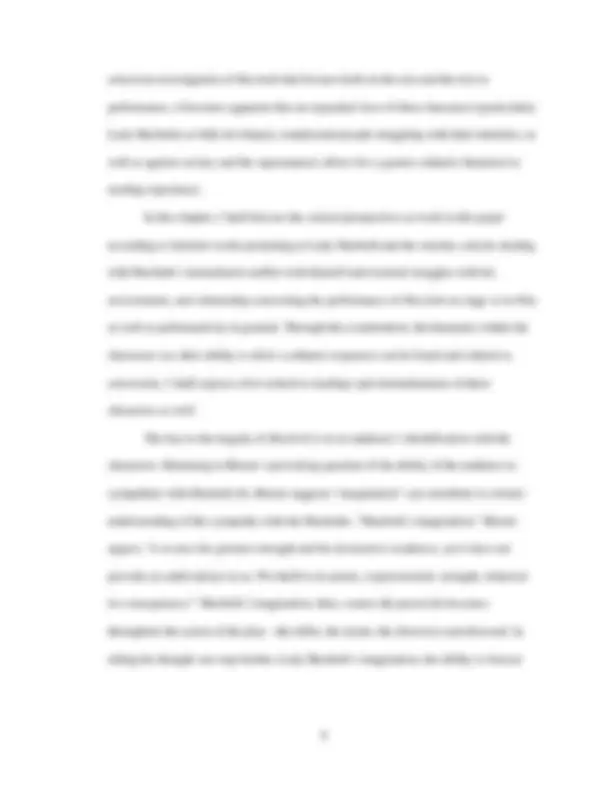
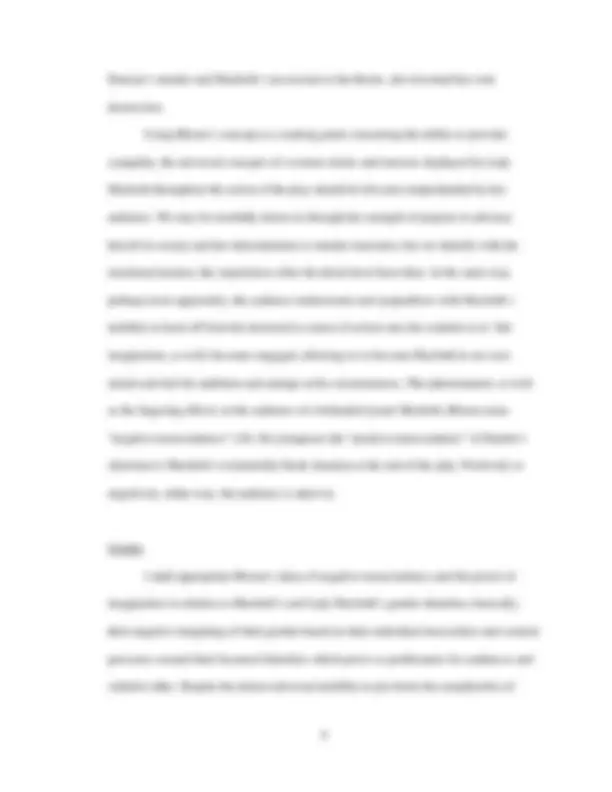
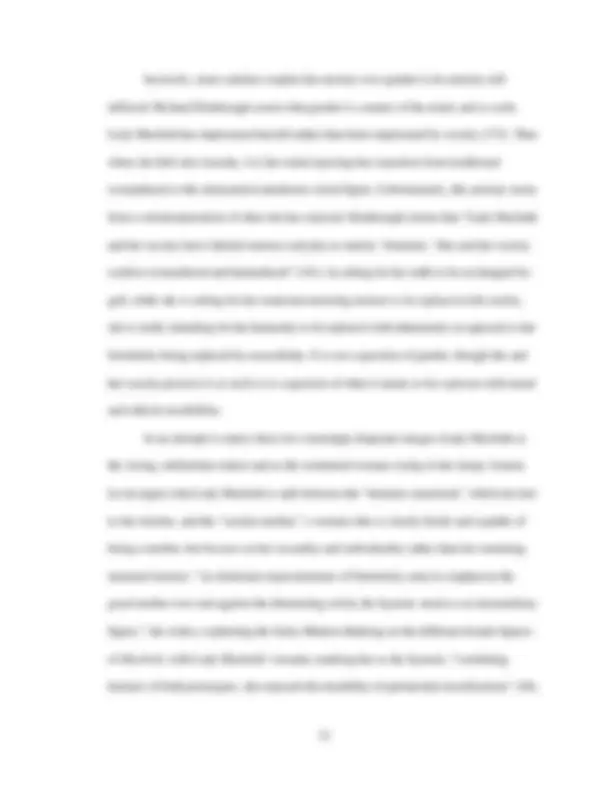
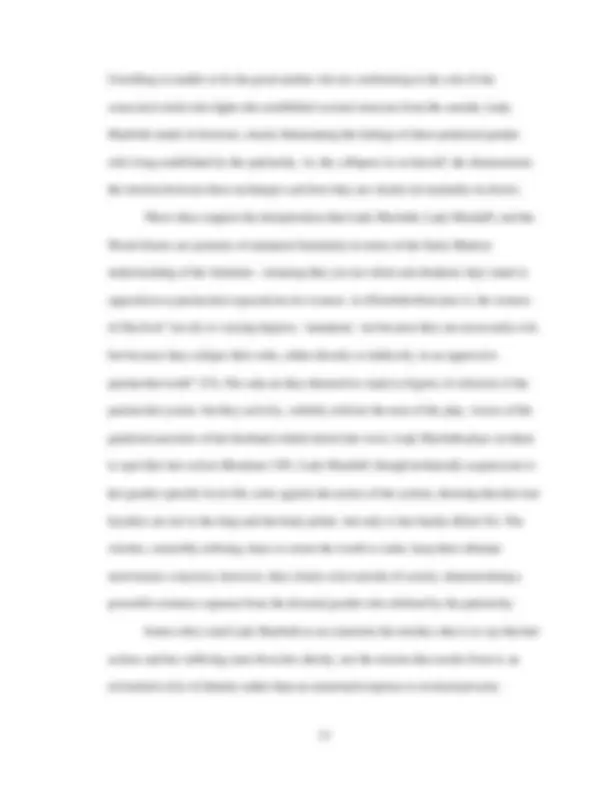
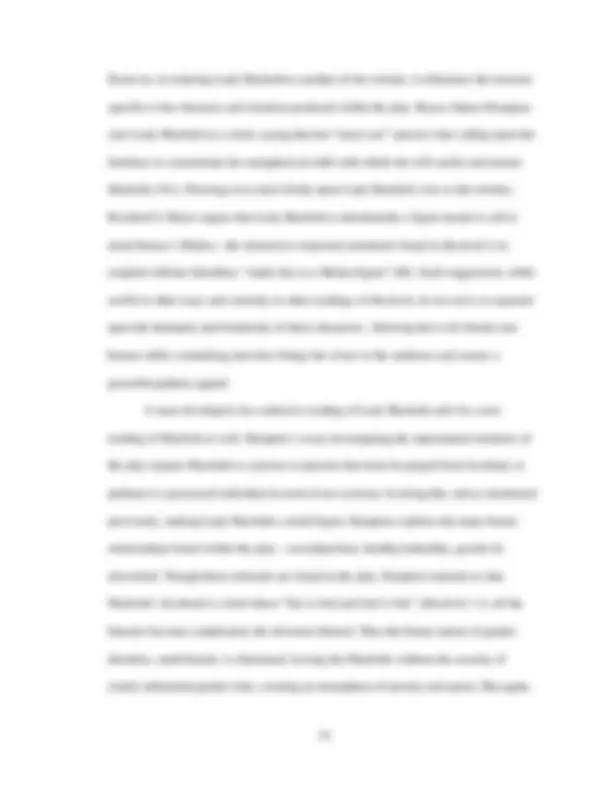
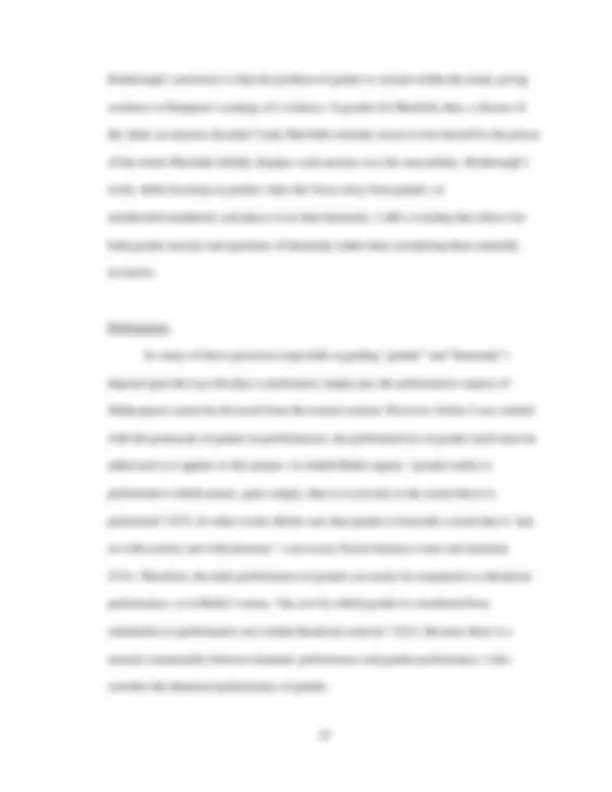
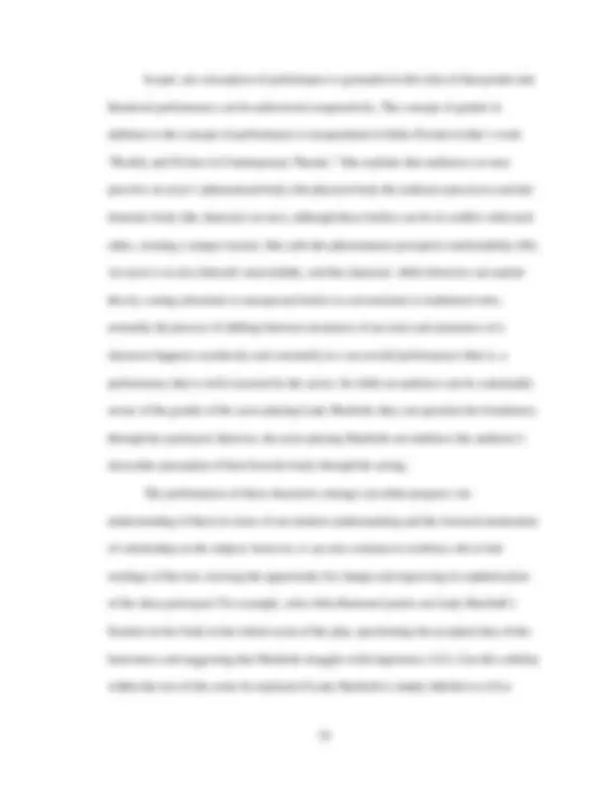
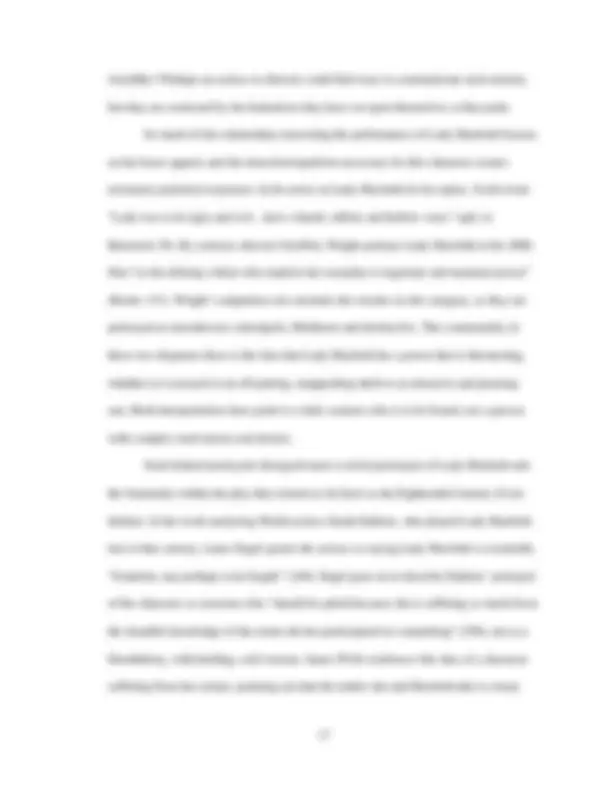
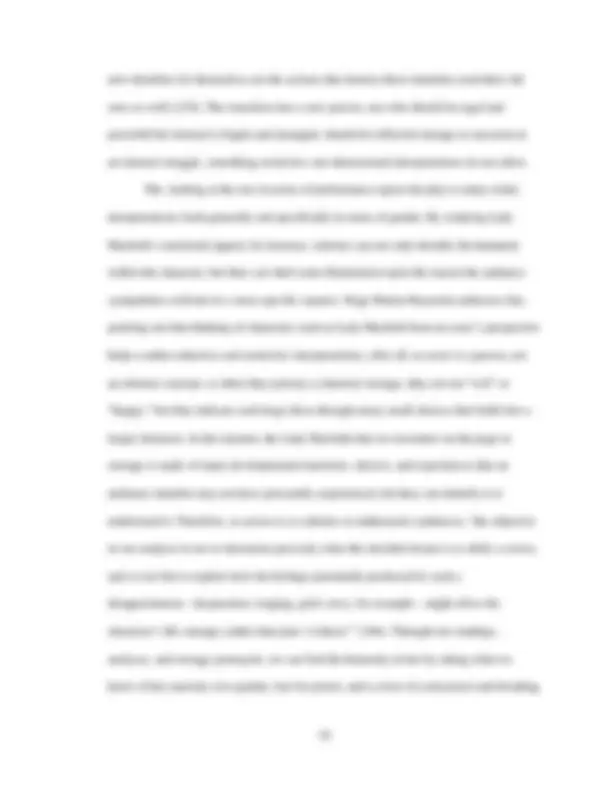
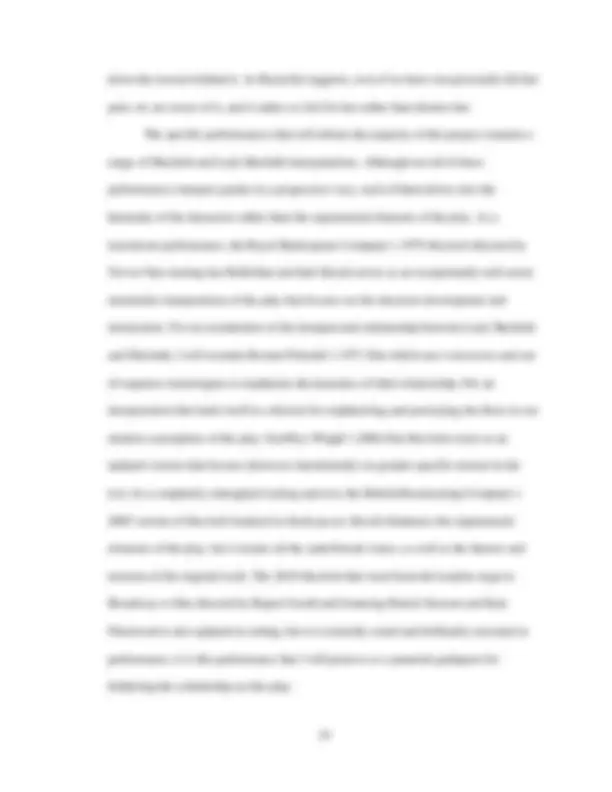
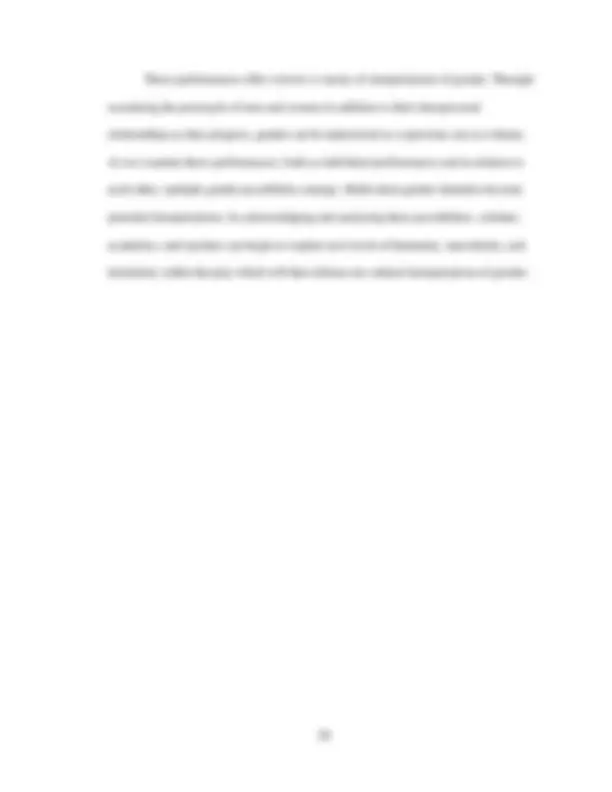
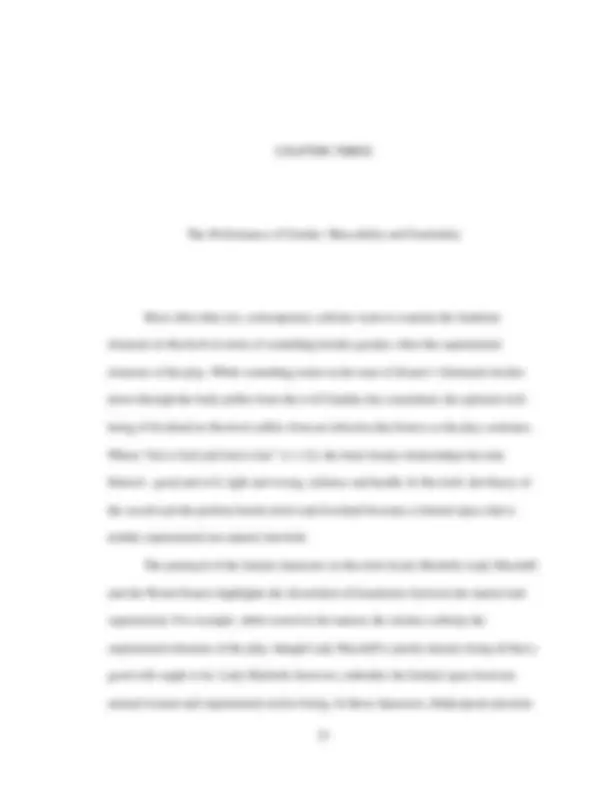
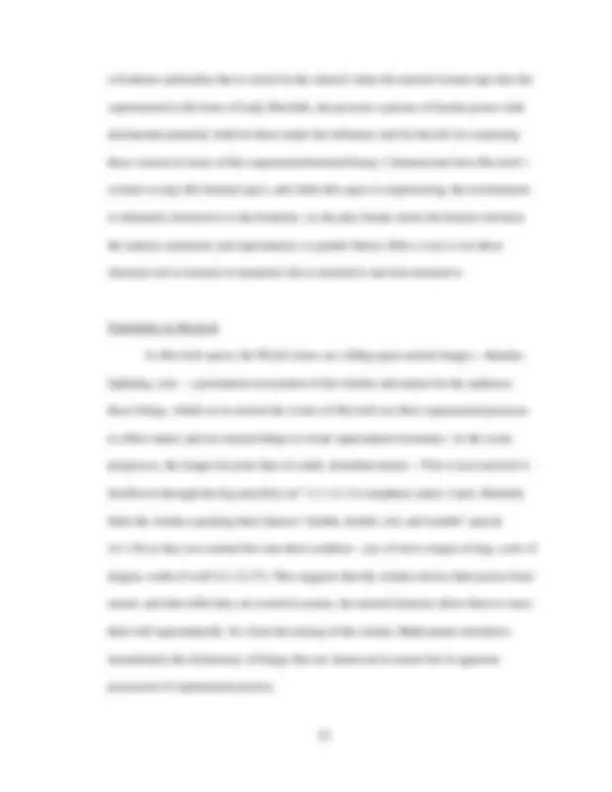
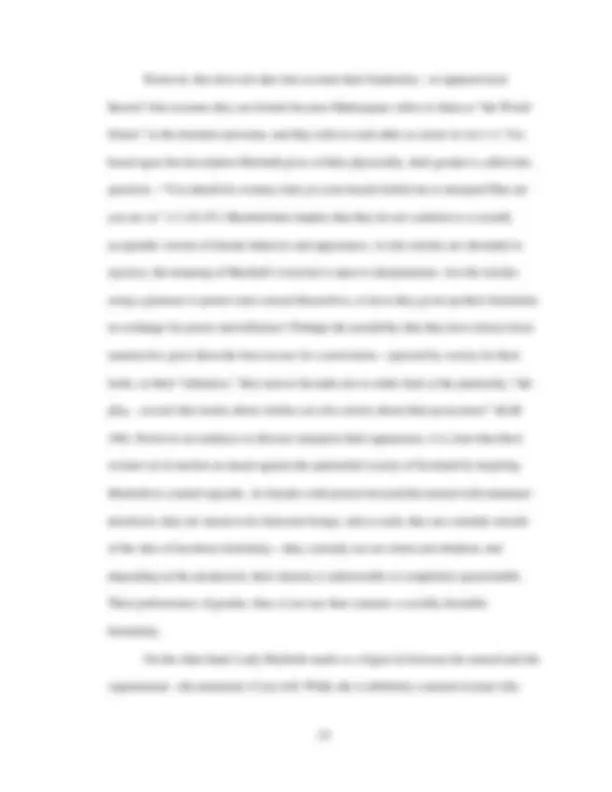
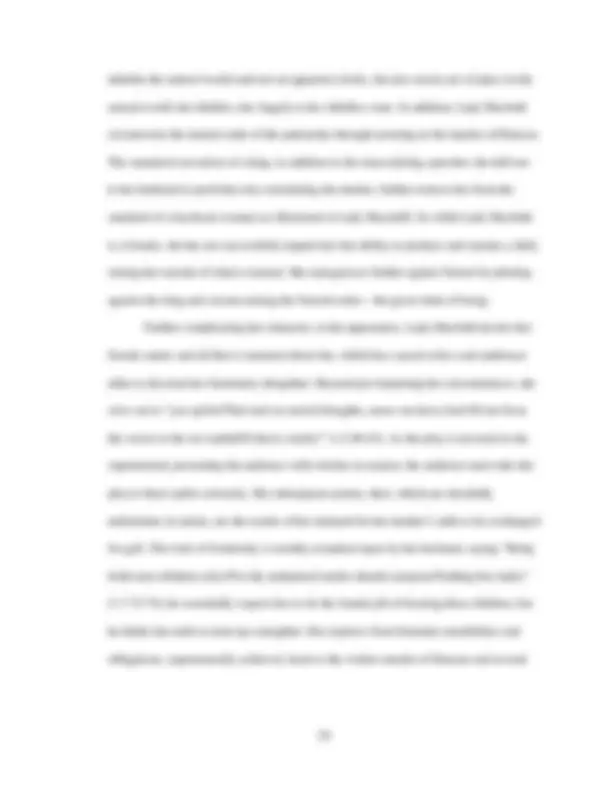
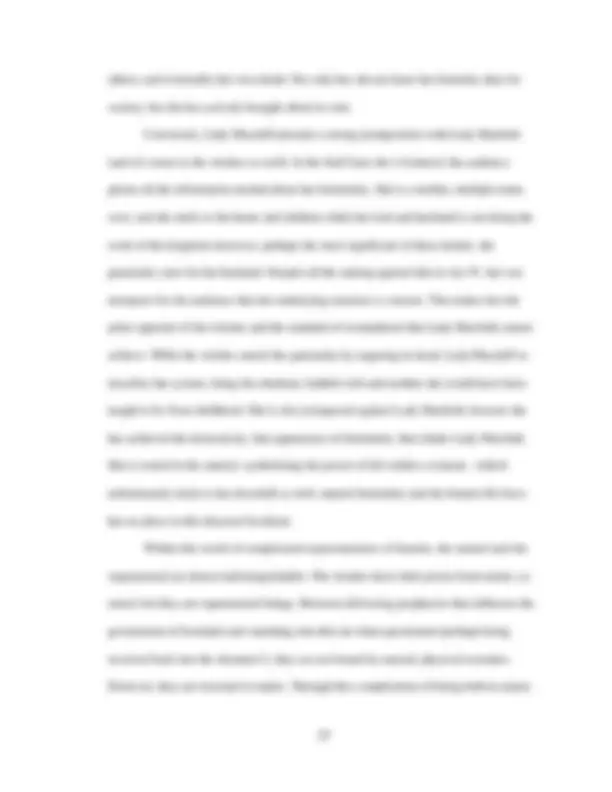
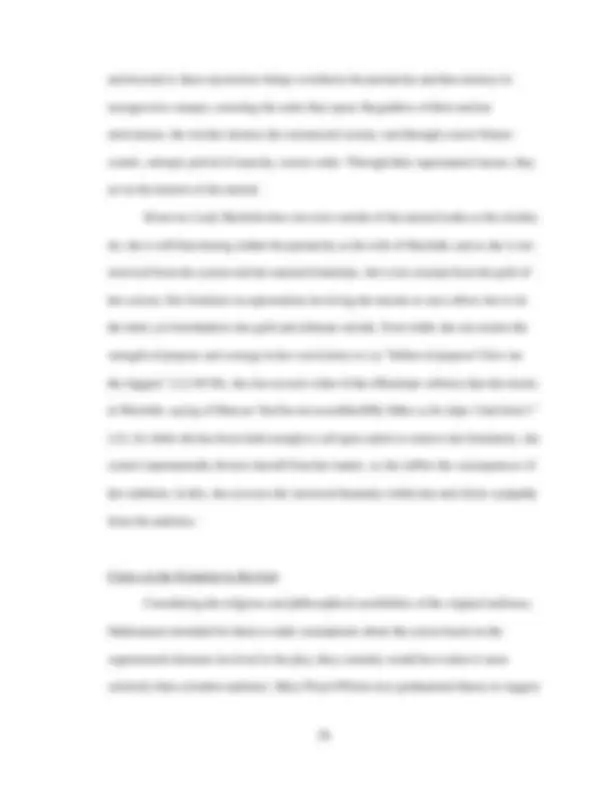
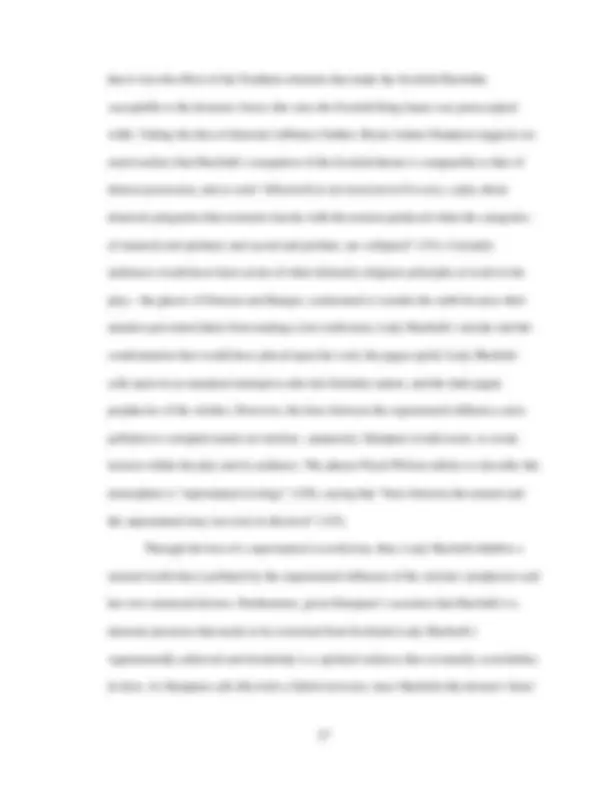
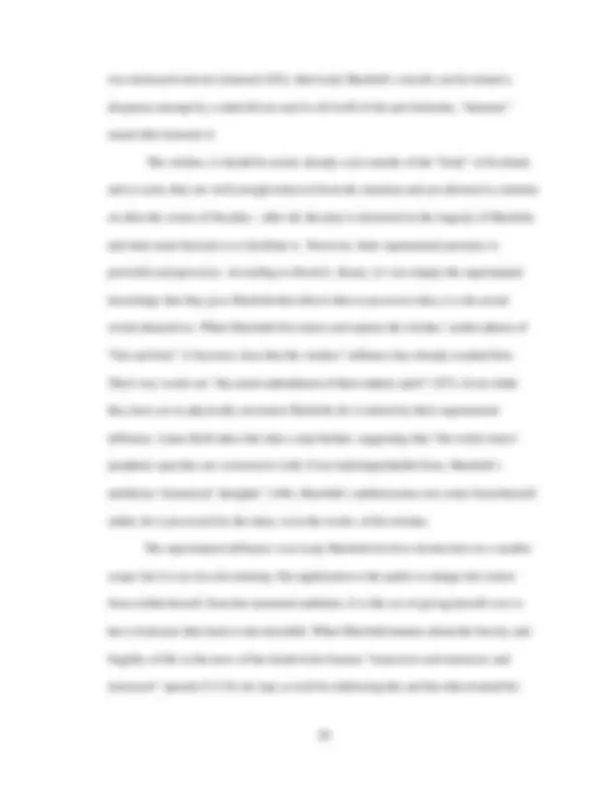
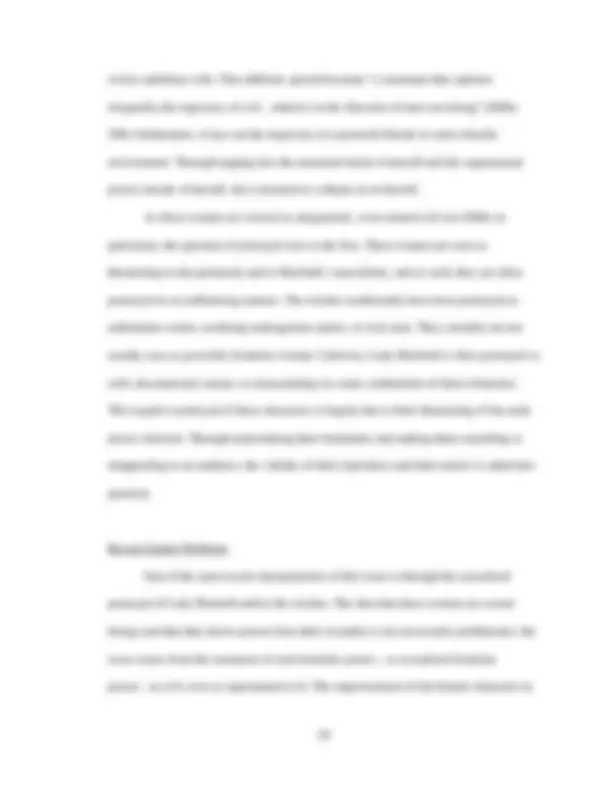
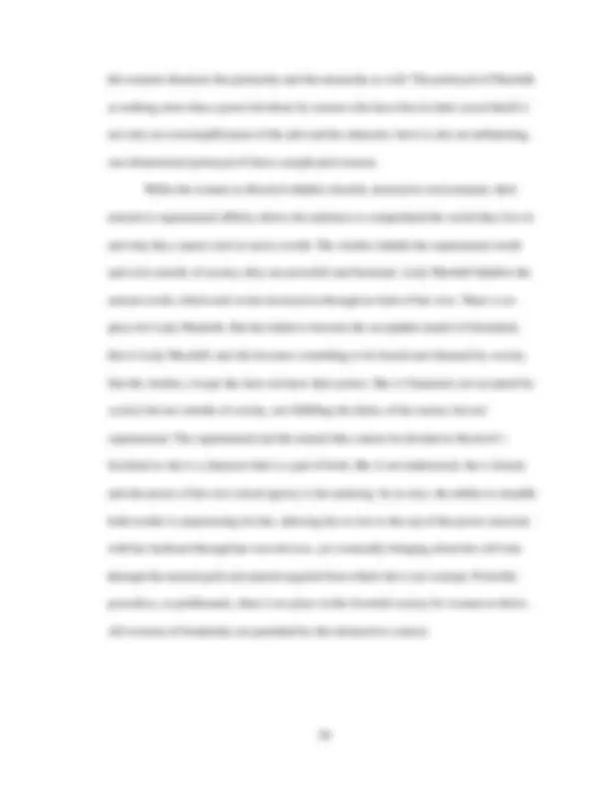
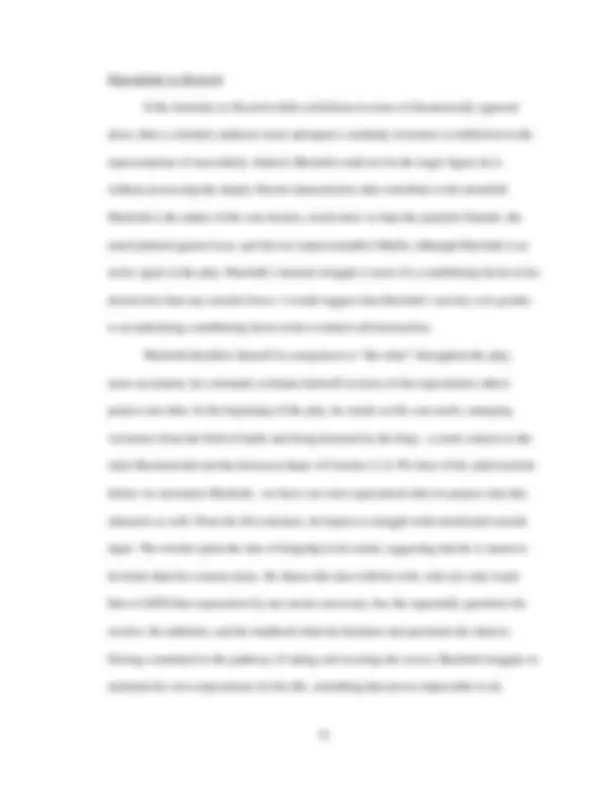
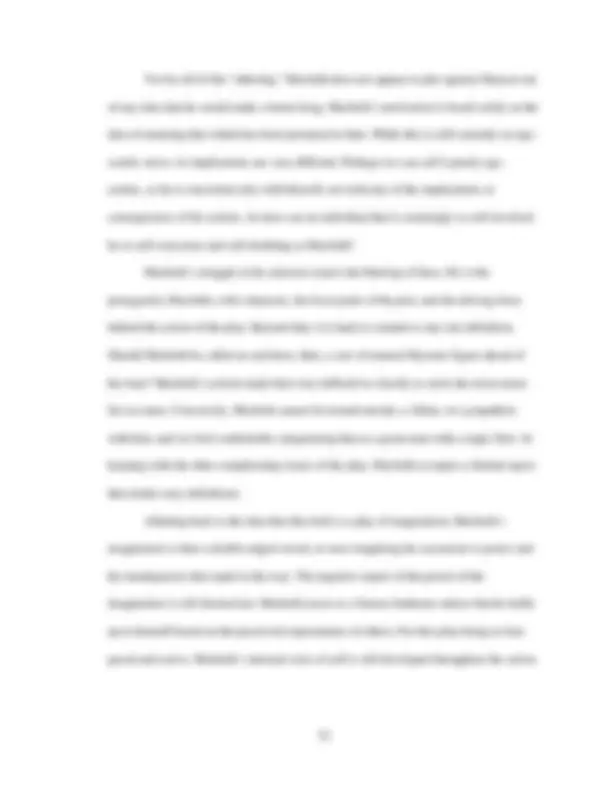
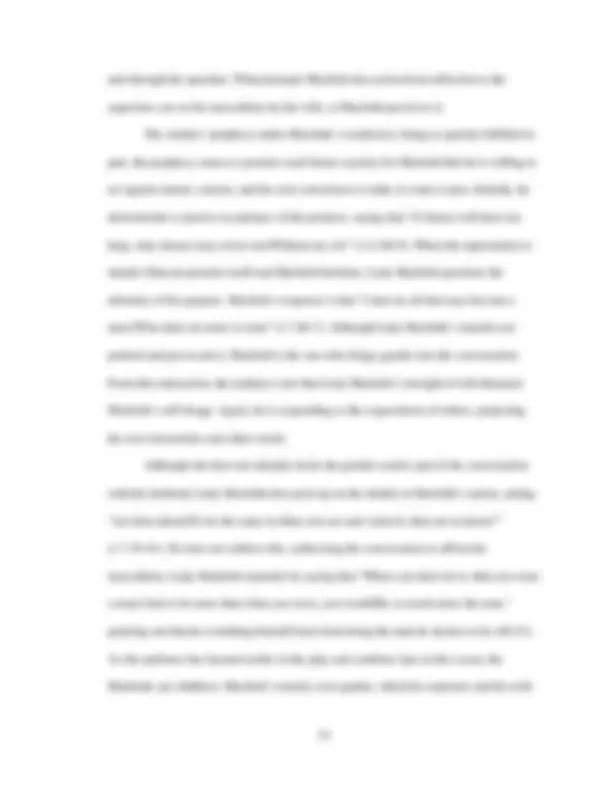
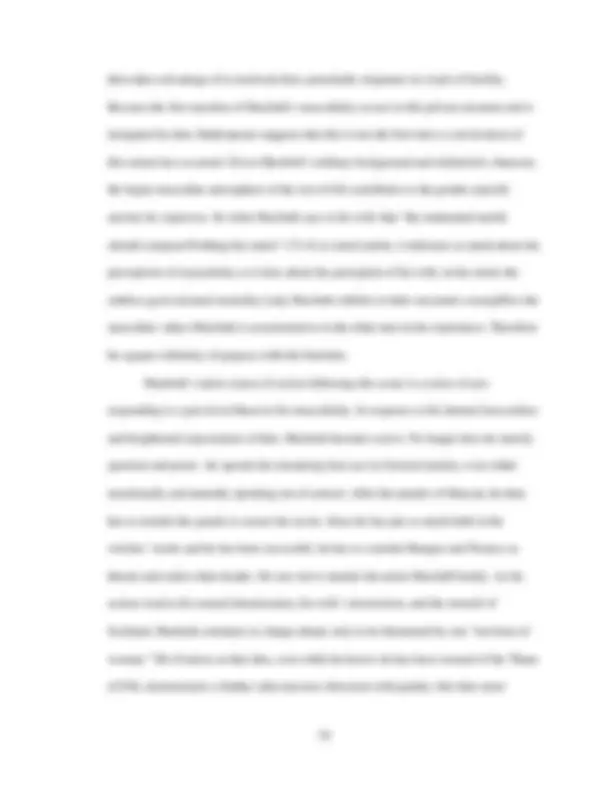
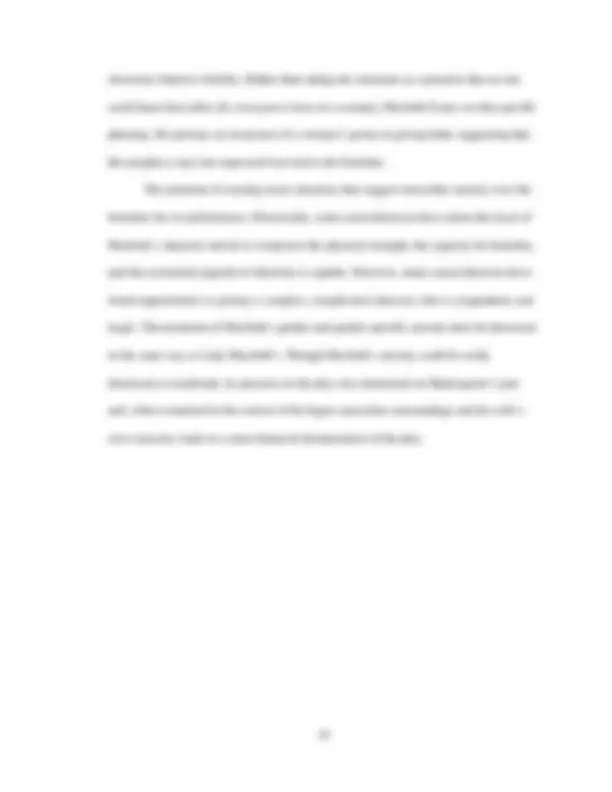
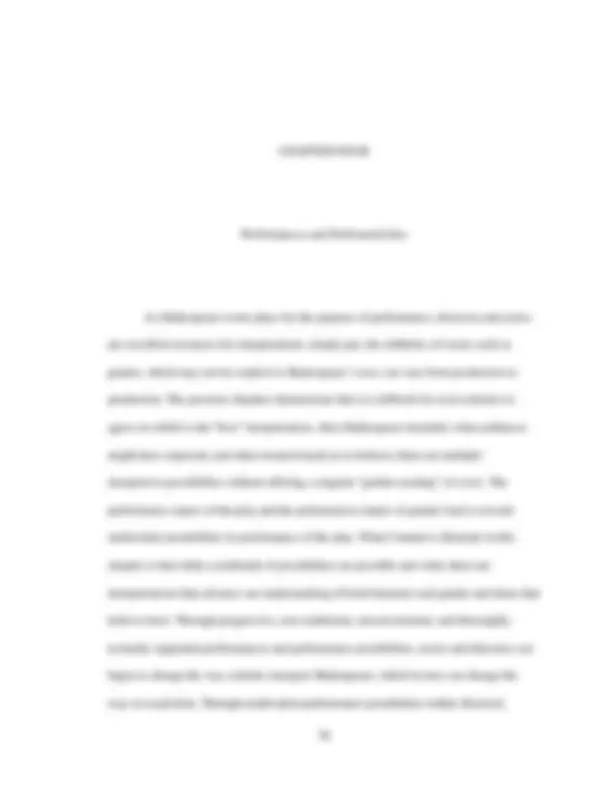
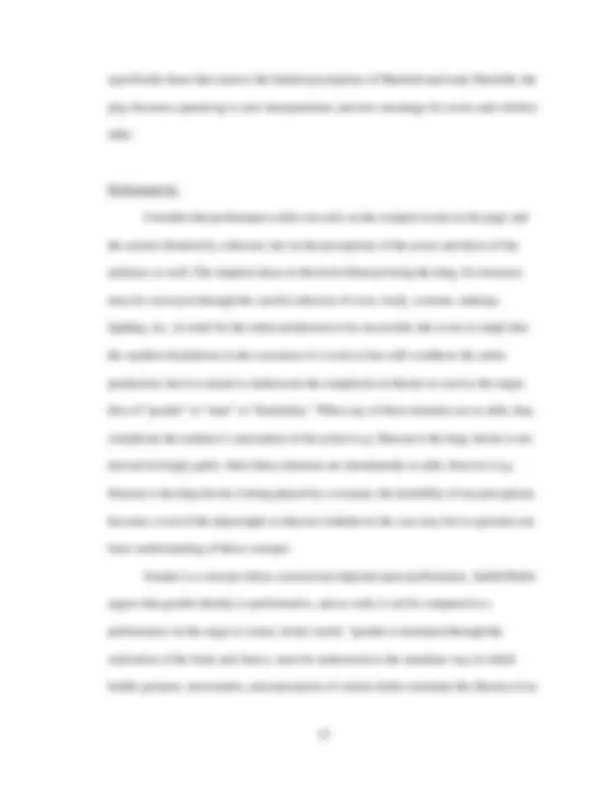
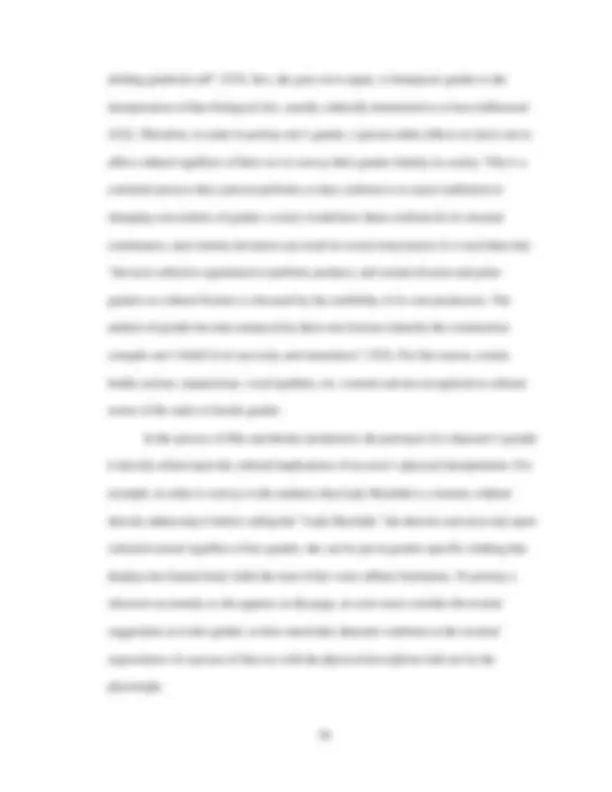
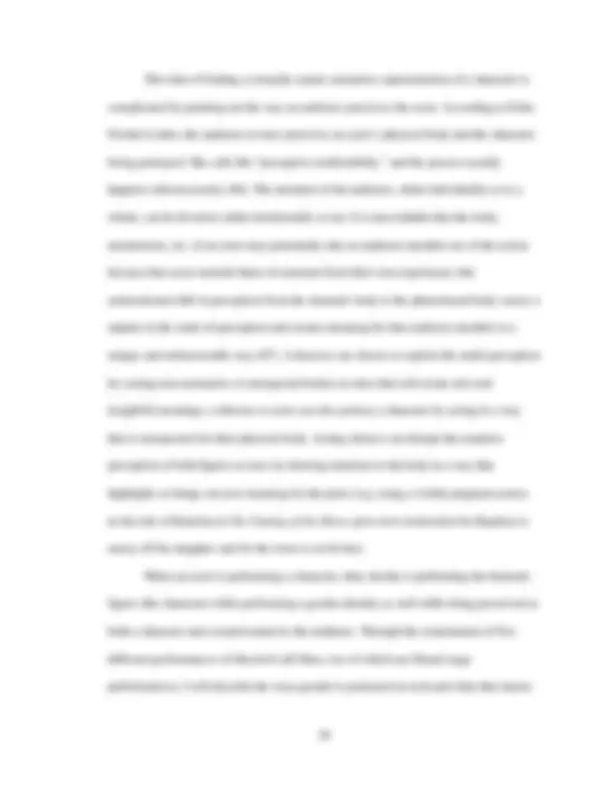
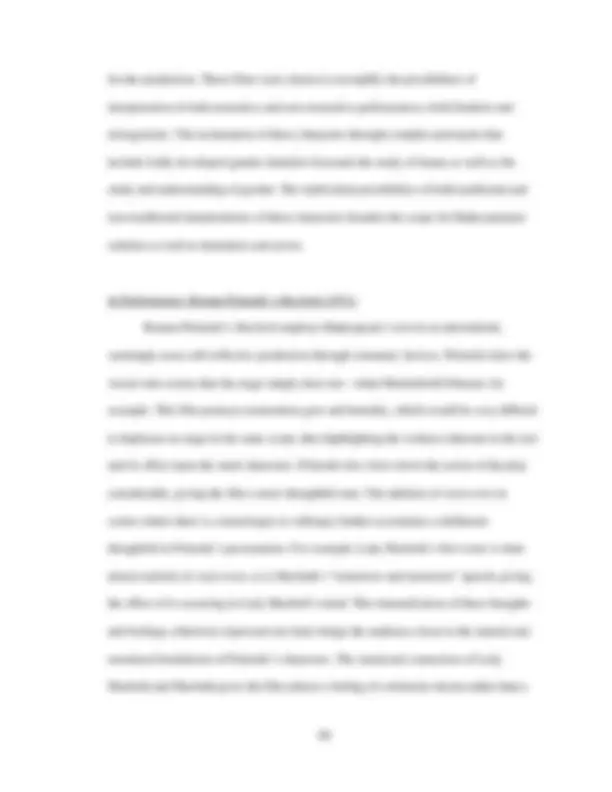
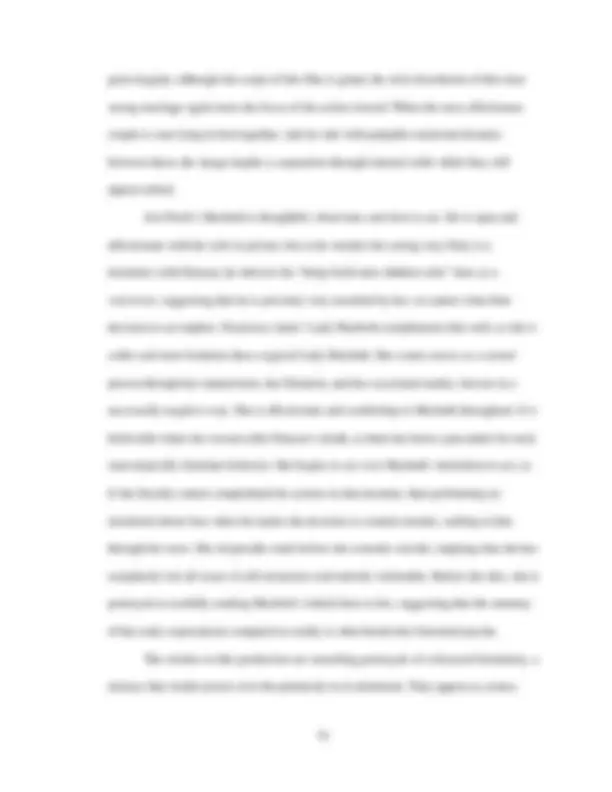
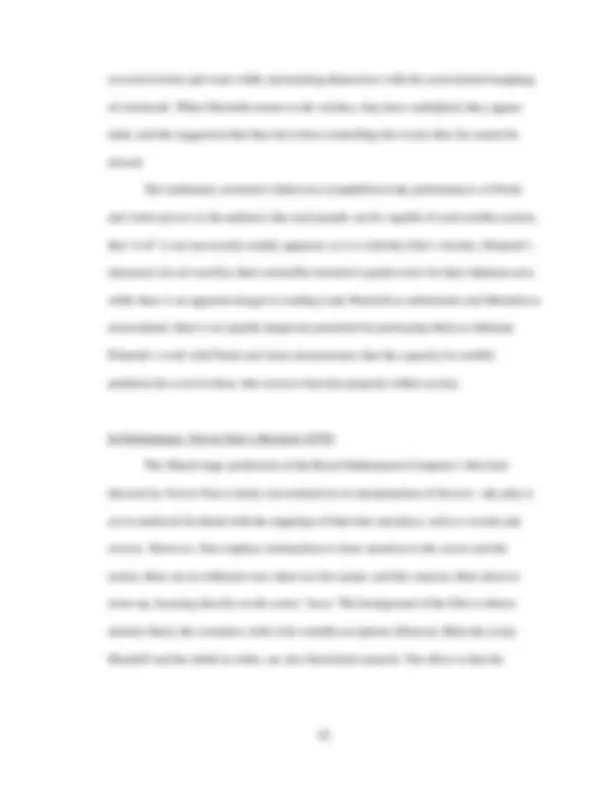
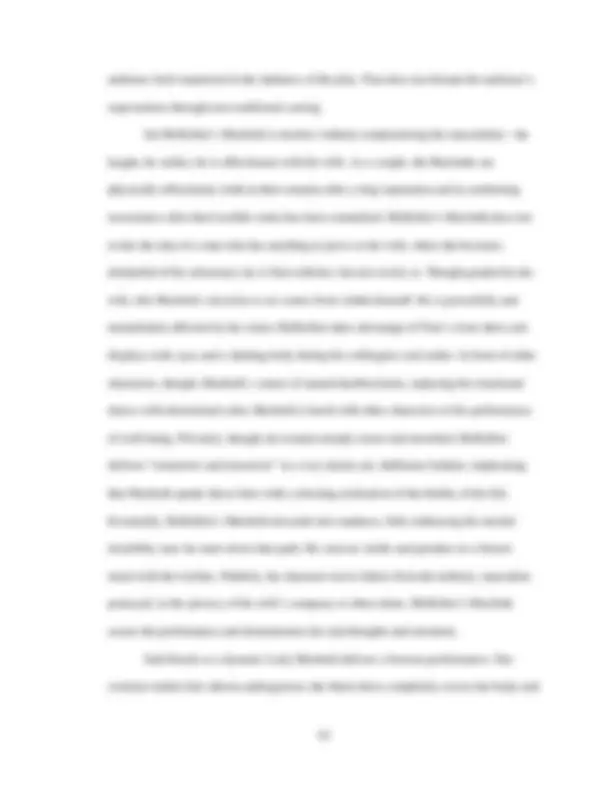
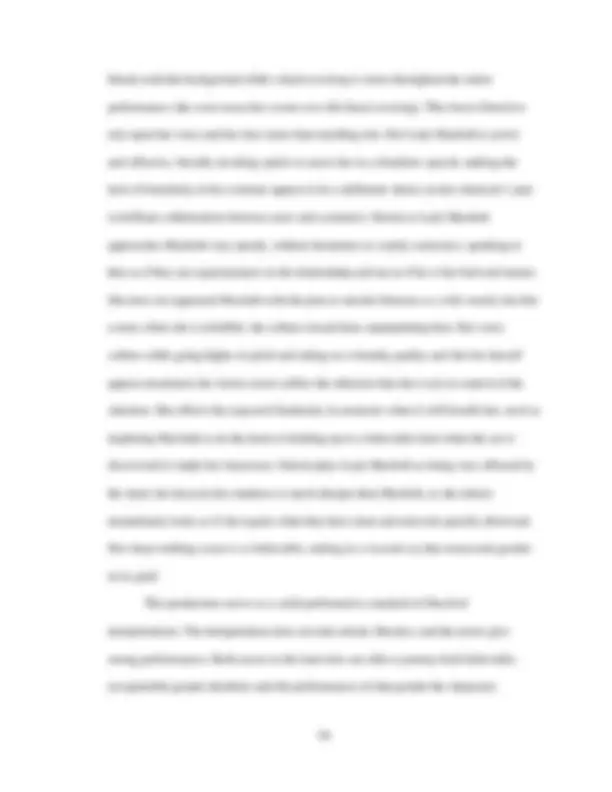
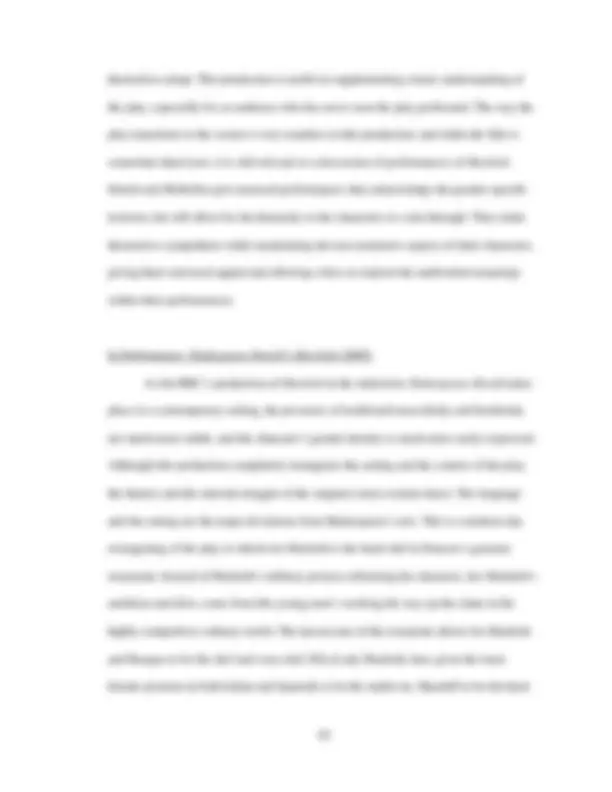
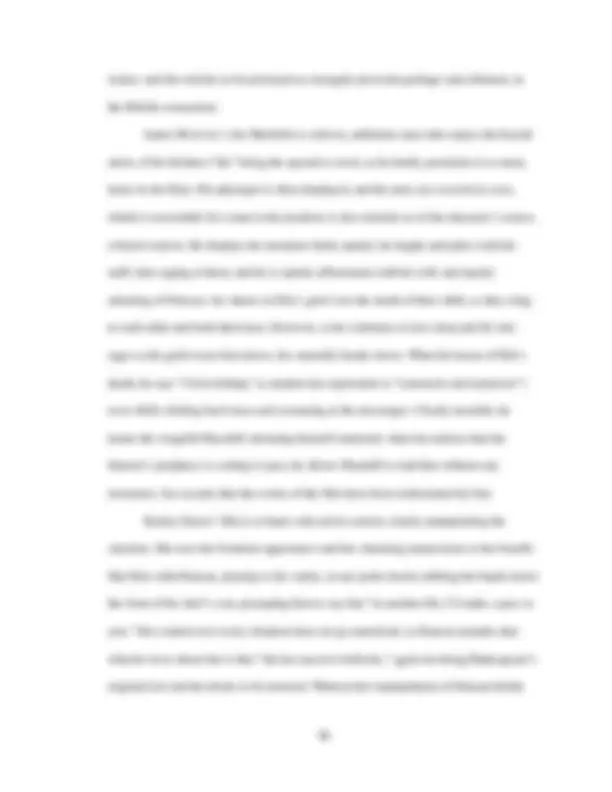
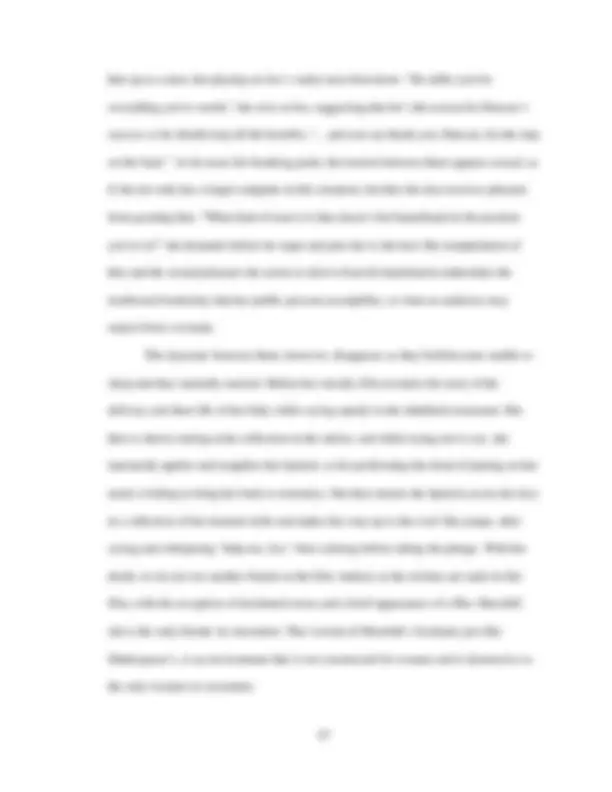
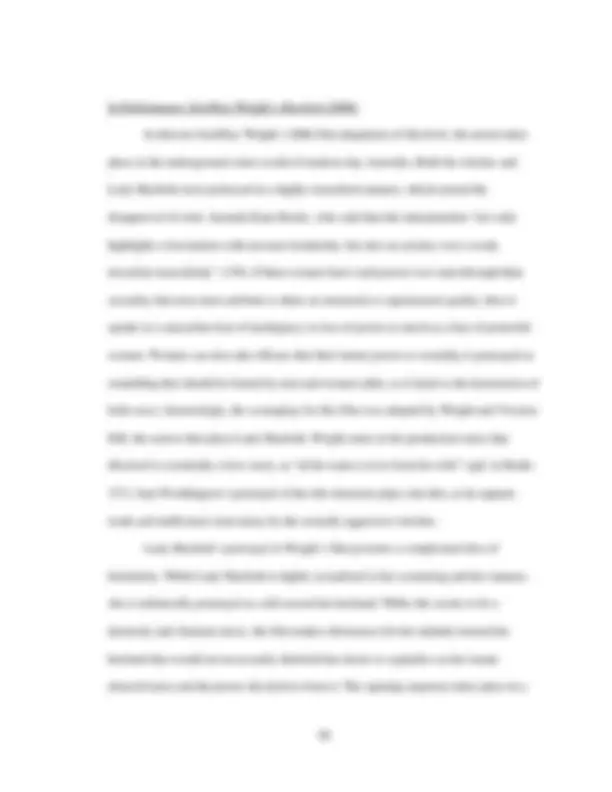
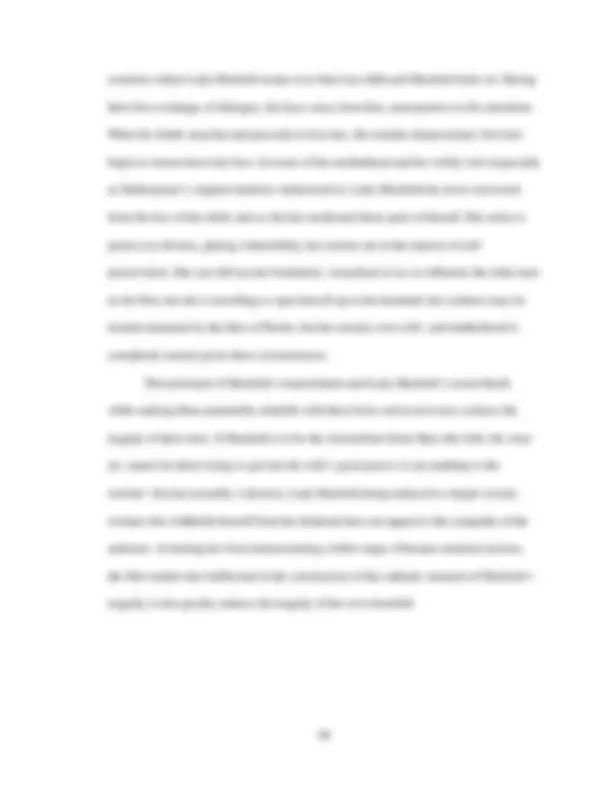
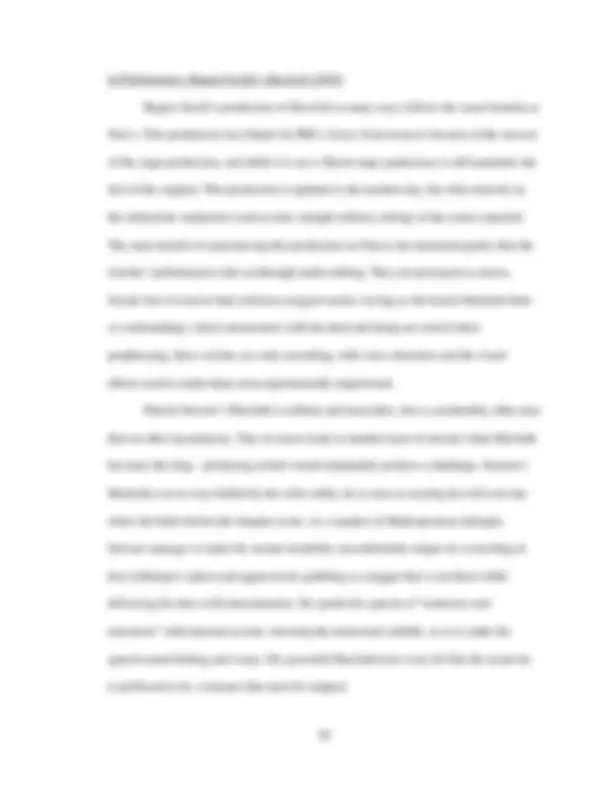
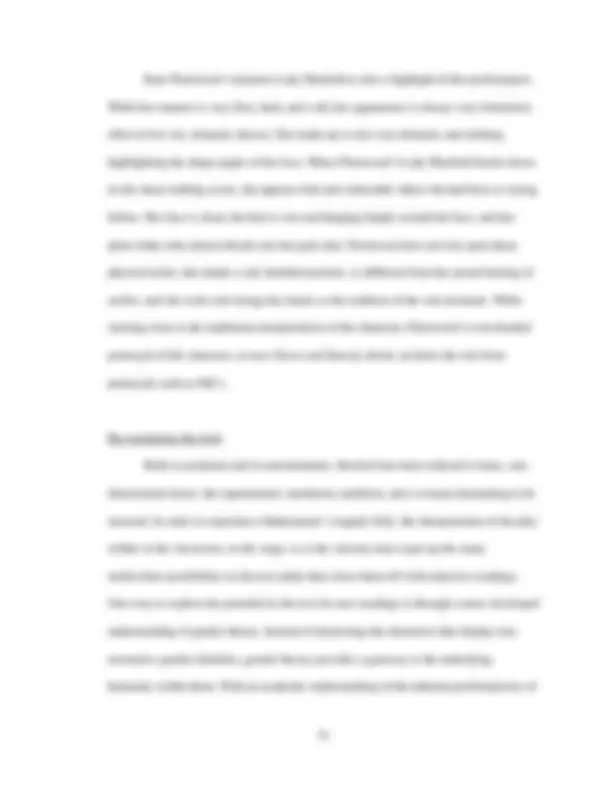
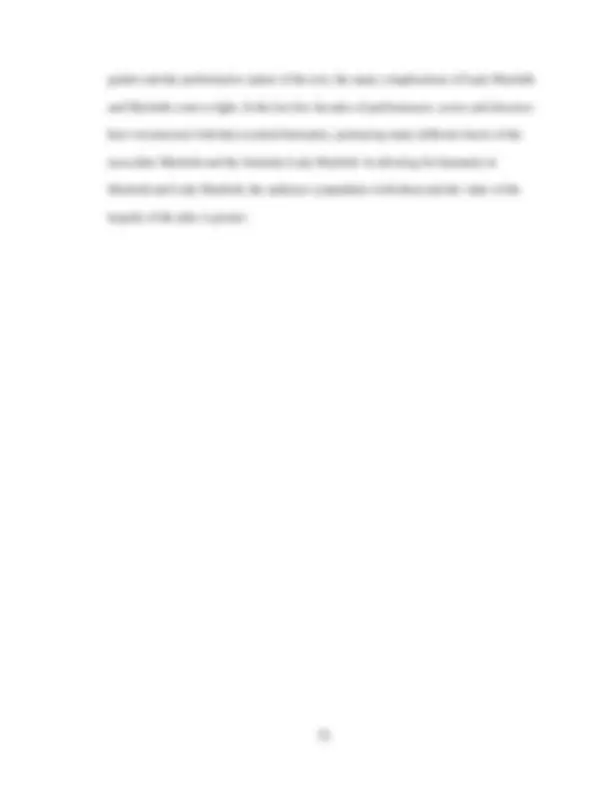
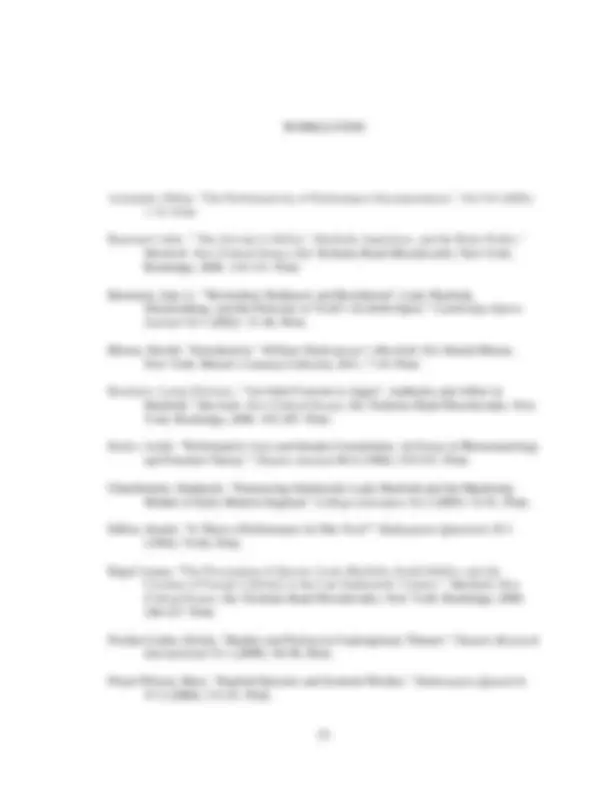
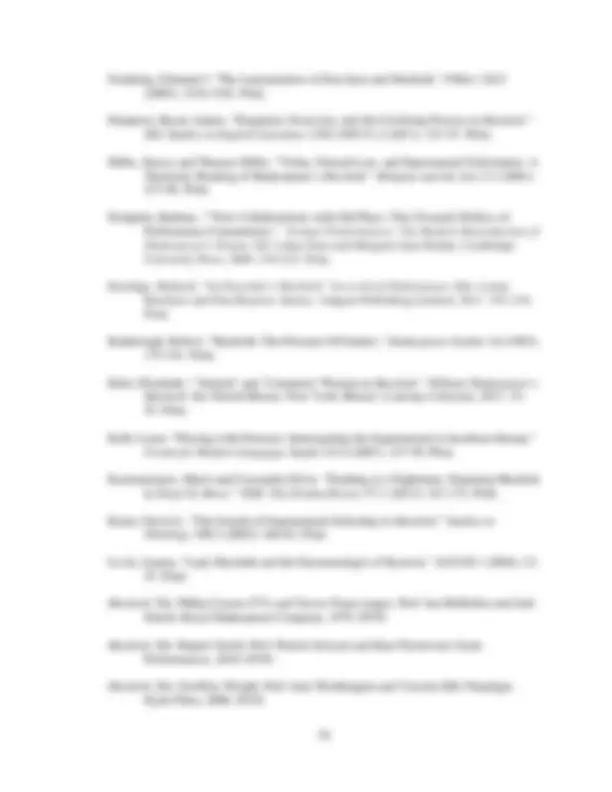
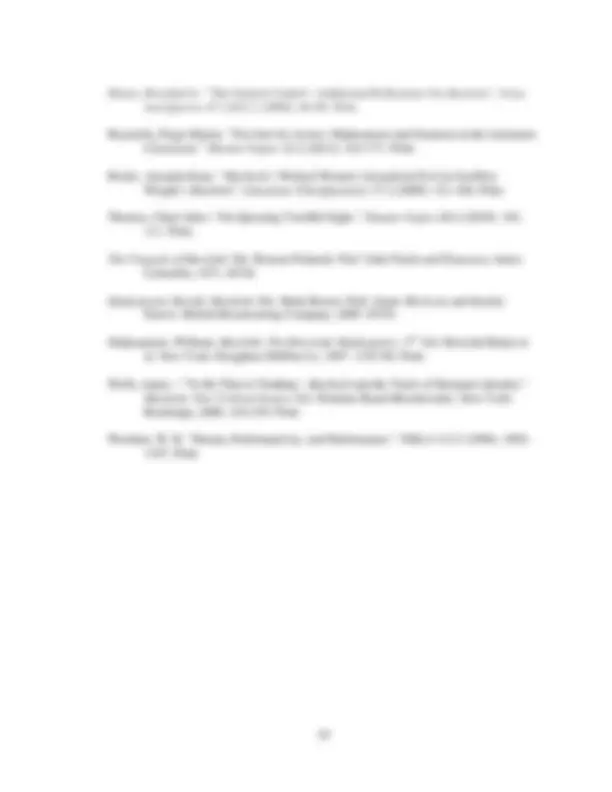


Study with the several resources on Docsity

Earn points by helping other students or get them with a premium plan


Prepare for your exams
Study with the several resources on Docsity

Earn points to download
Earn points by helping other students or get them with a premium plan
Community
Ask the community for help and clear up your study doubts
Discover the best universities in your country according to Docsity users
Free resources
Download our free guides on studying techniques, anxiety management strategies, and thesis advice from Docsity tutors
The figure of Lady Macbeth in Shakespeare's Macbeth through a feminist lens. The author discusses the dismissive attitude towards Lady Macbeth in scholarship and how her gender identity affects the interpretation of the play. The document also suggests that recent productions and scholarship do not fully consider the audience connection to Macbeth and Lady Macbeth and the cultural progression towards a more evolved understanding of gender. The author argues for a more sophisticated approach to understanding these characters and their impact on the play.
Typology: Study notes
1 / 61

This page cannot be seen from the preview
Don't miss anything!






















































by CHRISTA REAVES A THESIS Submitted in partial fulfillment of the requirements for the degree of Master of Arts in The Department of English to The School of Graduate Studies of The University of Alabama in Huntsville HUNTSVILLE, ALABAMA
v
The work described in this thesis would not have been possible without the assistance of certain people who deserve special mention. I would like to thank Dr. Chad Thomas for his invaluable guidance and unfailing encouragement throughout all the stages of the work. I would also like to thank Dr. Anna Foy and Dr. Joseph Taylor who also served on my committee and provided excellent feedback and unique perspectives on my work.
To my parents, Bill and Cindy, who listened to me talk about the Scottish play ad nauseum for the past two years.
Lady Macbeth’s (Gender) Troubles “I dare do all that may become a man/Who dares do more is none.” Macbeth 1.7.46-
In my first year of graduate school, I studied Macbeth in my Shakespeare seminar class. During our classroom discussion of the play, one of my classmates bluntly stated that Lady Macbeth is crazy. Although I am certain that this was not the first time I had heard this sentiment expressed, it struck a nerve. I began a feminist investigation into the play centered on the figure of Lady Macbeth, and in my seminar paper, I discovered that the dismissive attitude of my colleague toward Lady Macbeth appeared throughout the scholarship I encountered in my research, but the reasons for Lady Macbeth’s “craziness” tends to be reductive: she is a “difficult” character. In this era of criticism, why were students and scholars content to write off a major character simply because she was difficult? Where was the Shakespearean humanity, so prevalent in consideration of other difficult characters (Othello, Prospero, Richard III), in this treatment of her? Why did scholars, in print and in the classroom alike, refuse to accept her as a person? The more I researched this question of Lady Macbeth’s humanity, the more I became convinced that critical reduction of her was due to the performance of the text— or rather the performativity of Macbeth (the play itself). My personal history as an actor
perhaps gives me a unique perspective on this issue, but I wanted to make a connection, both as a scholar researching a text and as an actor preparing a script, because academics and theatregoers alike are consumers of Shakespeare’s plays. This insight led me to a new set of questions issues: As scholars and as performers, how can we understand this character and make her relatable to our students and our audiences? Is it not possible to relate to her? Why do we hold ourselves back from connecting to the humanity in her? In attempting to answer these questions, I found that rather that the interpretation and reception of Lady Macbeth directly affected our interpretation of Macbeth himself, and as such, my research became more about the performance of gender within the play and less about feminism. In examining the way scholars and performers interpret these characters in terms of gender, our cultural expectations of masculinity and femininity are exposed along with the anxieties concerning gender within the text. As my initial investigation into feminist scholarship concerning Macbeth indicated a dearth of critical work sympathetic to the character of Lady Macbeth, subsequent research demonstrated an inability on the part of scholars to categorize her. The gender of the witches is textually called into question and thus easy to dismiss in an examination of gender. Lady Macduff, although an intriguing feminine figure, only appears in one scene, and as such is not the focus of the critical conversation. Lady Macbeth, despite being both a character of significant textual importance and the major female figure in the play, appears in scholarship in simple, unflattering, reductive terms. The more she was reduced, the more the interpretation of Macbeth’s character was reduced as a consequence. If Lady Macbeth was an unsexed shrew instead of a lady, then Macbeth became a man cowering before a harpy rather than a king and a warrior. In
What is within Macbeth and Lady Macbeth that creates this connection to the audience and the sympathy such connection inspires is their innate humanity. These individuals, as is typical of Shakespeare’s characters, possess an essential humanity—a kernel of universal essence that gives a person her personhood. This part of these characters speaks to audiences despite their inhumane actions (actions that betray that universal human essence in them or in others). Although an audience member (or a reader, for a reader is simply an audience of one with more creative control) may not relate to Macbeth’s ambition specifically, he can relate to his suffering in the wake of his actions. Alternately, a woman may not understand Lady Macbeth’s ambition to murder Duncan, but she may sympathize with her moments of hesitation in the action. When Lady Macbeth succumbs to madness, the audience feels something, because it is human nature to be haunted by our mistakes and it is human nature to sympathize with the suffering of others. Human nature, then, describes those behaviors that connect to the universal, essential humanity; as such, the term applies to both good qualities and faults. If humanity is essential in terms of this argument, then gender is constructed. Humanity then encompasses those qualities that we would define as human. Whereas humanity is an inescapably inborn part of identity, each person creates individually. As opposed to a person’s sex, which is biological, gender is a constructed identity that a person enacts constantly and continually. Gender is active, a performative process that melds cultural expectations with internal realities. To speak of femininity, then, is to consider the “femaleness” of a character, including qualities that tie in to biological womanhood but expand beyond that. Often, cultural expectations of femininity are at odds with the realities of a character’s expression of femininity, particularly in the
case of Lady Macbeth. The same is true of masculinity and the expression of it. Then, gender is performative in Macbeth —meaning that audiences perceive gender only as it is performed, but also that gender is dependent upon performance because the text is being performed as well. Furthermore, the spectrum of the natural, the unnatural, and the supernatural, emphasized throughout Macbeth , is essential to this investigation of gender. Shakespeare blurs the lines between natural and supernatural events in Macbeth ’s Scotland through the inclusion of the witches, prophecies, and the disruption of the Great Chain of Being (a Neo-Platonic hierarchy important in medieval culture suggesting that everything in the world stems from God.) Shakespeare extends natural and supernatural to include a third category—unnatural—that makes the dynamics of the relationship between the ideas more like grades on a spectrum rather than diametrically opposed mutually exclusive concepts. Whereas the “natural” encompasses that which is allowed for in nature and the “supernatural” is that which occurs outside the boundaries of nature, then the “unnatural” is that which should not occur within nature. A common misconception among Shakespearean scholarship on the topic of gender (femininity in particular) is the idea that non-normative behavior, especially when gender-coded, is unnatural. If Lady Macbeth is a sympathetic character, however, then her actions can be understood as natural even though they are outside of the cultural expectations of a female of her age and station; the same is true of Macbeth and his masculinity. This understanding of nature and the spectrum of the natural, unnatural, and supernatural becomes important to a critical interrogation of the text of Macbeth because the play complicates the binaries and dichotomies at work in the text. The Macbeths complicate the audience’s expectation
Gender, Performance, Performativity
In the last few decades, scholarship on Macbeth has yet to fully reflect the evolution of critical thought with the influence of newer critical theories and literary fields; specifically, the portrayal and analysis of gender in the play demands more attention. Initially, my research reflected a dearth of scholarly writing dealing specifically and definitively with the females in Macbeth , and what existing material that was found pertaining to them often failed to offer progressive views on the subject. In addition, typically Macbeth is too easily written off as emasculated, with gender represented in a very limited manner. With the advent of feminist theory, gender studies, and performance theory in the latter part of the last century, the approach taken to Lady Macbeth, the Weird Sisters, and Macbeth should reflect more sophistication, seeking to overturn centuries of parochial thought on the representations of gender in this play. In pondering Bloom’s insistence on the appeal of Macbeth, which I introduced in the previous chapter that in spite of their actions the Macbeths elicit sympathy, I question the emotional appeal of the Macbeths as one-dimensional and unmotivated when there is clear turmoil and instability surrounding their gender identities. Through a gender-
conscious investigation of Macbeth that focuses both on the text and the text in performance, it becomes apparent that an expanded view of these characters (particularly Lady Macbeth) as fully developed, complicated people struggling with their identities, as well as against society and the supernatural, allows for a greater cathartic theatrical or reading experience. In this chapter, I shall discuss the critical perspectives at work in this paper according to feminist works pertaining to Lady Macbeth and the witches, articles dealing with Macbeth’s internalized conflict with himself and external struggles with his environment, and scholarship concerning the performance of Macbeth on stage or in film as well as performativity in general. Through this examination, the humanity within the characters (or, their ability to elicit a cathartic response) can be found and related to; conversely, I shall expose a few reductive readings and rationalizations of these characters as well. The key to the tragedy of Macbeth is in an audience’s identification with the characters. Returning to Bloom’s provoking question of the ability of the audience to sympathize with Macbeth (8), Bloom suggests “imagination” can contribute to a better understanding of this sympathy with the Macbeths. “Macbeth’s imagination,” Bloom argues, “is at once his greatest strength and his destructive weakness, yet it does not provoke an ambivalence in us. We thrill to its poetic, expressionistic strength, whatever its consequences.” Macbeth’s imagination, then, creates the person he becomes throughout the action of the play—the killer, the tyrant, the obsessive and obsessed. In taking his thought one step further, Lady Macbeth’s imagination, her ability to foresee
gender within this play (or a disinterest in doing so), the essential problems that these characters struggle with throughout the play—how to be a husband/wife, king/queen, man/woman—transcend the stage or page and haunt the audience. The audience identifies with Lady Macbeth and Macbeth despite their actions and flaws, to which this negative transcendence contributes; the anxiety of gender we observe in the Macbeths lurks in all of us. In the study of feminism and performance alike, gender is defined not as something that is a state of being but rather as something one performs, consciously or unconsciously. As Judith Butler posits, “gender is in no way a stable identity…rather, it is an identity tenuously constituted in time—an identity instituted through a stylized repetition of acts” (519). She goes on to trace the idea of “woman” as opposed to “female” to Simone de Beauvoir’s work, arguing that there is a distinction between “sex, as a biological facticity, and gender, as the cultural interpretation or signification of that facticity” (522). To clarify, if male/female are biological distinctions and man/woman are gender identities, then the insecurity, instability, and anxiety within the play are concerned with gender—that is to say, they are concerned with the cultural significance or interpretation of manhood/womanhood. Lady Macbeth’s anxiety over gender in particular is most problematic for scholars to come to terms with; yet it is in her suffering over her actions that Shakespeare displays her humanity. Traditionally, scholarship has been unwilling to consider the implications of her descent into self-destructive insanity. The rather strong impression Lady Macbeth leaves on the audience in her initial scenes (her invocation to the spirits and the spurring of her husband into action) is seemingly insurmountable for some critics (Rosalind S.
Meyer and Bryan Adams Hampton, to name a few). Others, such as Paige Martin Reynolds and Joanna Levin, consider the madness and the apparent angst she feels later in the play to be the most telling facets of Lady Macbeth’s femininity. Although she has greatly contributed to this situation of disorder for herself and for the whole of Scotland, she has not gotten rid of the core of humanity inside of her that will be affected by her choices and their consequences. Beyond functioning as a critique of the patriarchy and the limited, restrictive roles of women (which I believe that she does), Lady Macbeth is also instrumental in showing an audience that humanity in oneself, even when rejected or suppressed, is very hard to extinguish. The trend among feminist critics of Macbeth is either (1) to focus on Lady Macbeth’s desire to be “unsexed” in an effort to subvert the patriarchy or (2) to examine her “insanity” and suicide as indicative of a patriarchal oppression that eventually crushes her. This points to critics’ reading in Lady Macbeth the desire not to become not-female, and not to become male, but to find an alternative for her strictly defined gender role. As Stephanie Chamberlain points out, “although she may well fantasize killing an infant, Lady Macbeth expressly rejects the masculine power which would allow her to wield a dagger... [she] ultimately refuses masculine authority. What she craves instead is an alternative gender identity, one which will allow her to slip free of the emotional as well as cultural constraints governing women” (79-80). Scholarship on Lady Macbeth should interpret her desire to be unsexed not as a desire to be male, which undermines the entire point of feminism, but as a desire to not be limited to the socially constructed idea of femininity.
Unwilling or unable to be the good mother, but not conforming to the role of the ostracized witch who fights the established societal structure from the outside, Lady Macbeth stands in between, clearly illuminating the failings of these polarized gender roles long established by the patriarchy. As she collapses in on herself, she demonstrates the tension between these archetypes and how they are clearly not mutually exclusive. These ideas support the interpretation that Lady Macbeth, Lady Macduff, and the Weird Sisters are portraits of unnatural femininity in terms of the Early Modern understanding of the feminine—meaning they are not silent and obedient; they stand in opposition to patriarchal expectations for women. As Elizabeth Klett puts it, the women of Macbeth “are all, to varying degrees, ‘unnatural,’ not because they are necessarily evil, but because they critique their roles, either directly or indirectly, in an oppressive patriarchal world” (53). Not only do they themselves stand as figures of criticism of the patriarchal system, but they actively, verbally criticize the men of the play. Aware of the gendered anxieties of her husband (which mirror her own), Lady Macbeth plays on them to spur him into action (Bruckner 195). Lady Macduff, though technically acquiescent to her gender-specific lot in life, rants against the norms of the system, showing that her true loyalties are not to the king and the body politic, but only to her family (Klett 54). The witches, ostensibly utilizing chaos to return the world to order, keep their ultimate motivations a mystery; however, they clearly exist outside of society, demonstrating a powerful existence separate from the dictated gender roles defined by the patriarchy. Some critics read Lady Macbeth as an extension the witches; that is to say that her actions and her suffering stem from her alterity, not the tension that results from it, an existential crisis of identity rather than an emotional response to societal pressure.
However, in reducing Lady Macbeth to another of the witches, it eliminates the tensions specific to her character and situation produced within the play. Bryan Adams Hampton cites Lady Macbeth as a witch, saying that her “unsex me” speech is her calling upon her familiars to contaminate her metaphorical milk with which she will suckle and nurture Macbeth (341). Drawing even more firmly upon Lady Macbeth’s ties to the witches, Rosalind S. Meyer argues that Lady Macbeth is intentionally a figure meant to call to mind Seneca’s Medea—the destructive maternal sentiments found in Macbeth I.vii, coupled with her bloodlust, “marks her as a Medea-figure” (88). Such suggestions, while useful in other ways and certainly in other readings of Macbeth , do not serve to expound upon the humanity and femininity of these characters. Allowing her to be female and human while committing atrocities brings her closer to the audience and creates a powerful pathetic appeal. A more developed, less reductive reading of Lady Macbeth calls for a new reading of Macbeth as well. Hampton’s essay investigating the supernatural elements of the play equates Macbeth to a poison or parasite that must be purged from Scotland, or perhaps to a possessed individual in need of an exorcism. In doing this, and as mentioned previously, making Lady Macbeth a witch figure, Hampton explores the many binary relationships found within the play—sacred/profane, healthy/unhealthy, good/evil, alive/dead. Though these elements are found in the play, Hampton reminds us that Macbeth’s Scotland is a land where “fair is foul and foul is fair” ( Macbeth 1.1); all the binaries become complicated, the divisions blurred. Thus the binary nature of gender identities, male/female, is eliminated, leaving the Macbeths without the security of clearly delineated gender roles, creating an atmosphere of anxiety and unrest. But again,